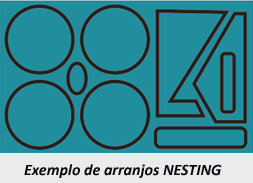Nesting
The English name nesting is used to define the type of process that leads to a cutting plane. Another meaning is “to arrange something inside something else”. In Portuguese, nesting would mean “nesting”. As the word does not exist, the closest found was “fitting”. “Arrangement” is also used (eg arrangement of pieces). After all, here in Brazil, nesting has been more used to identify the arrangement for irregular cuts – often combined with this Portuguese expression: arrranjo nesting.

In raw form: ex: tree trunks to be transformed into boards.
In plates: (or sheets, or plates, depending on the type of material, but with the same characteristic of presenting width and height).
In blocks: In cases where also the thickness of the material must be considered for the optimization in three dimensions in coils.
In bars, profiles and other linear materials: In which only the length of the material matters for the preparation of the cutting plane.
Specifically in sheet metal cutting, there are two types to consider:
Rectangular cuts: when all the angles of the pieces (or parts) to be cut form 90°; positioned, these pieces will always be parallel or perpendicular to the sides of the plates.
Irregular cuts: include both cuts with angles other than 90°, such as trapezoids and triangles, as well as curved cuts (circles and ellipses) and mixed cuts, of free creation. To perform these types of cuts, there are several technologies available, such as lasers, oxycut, plasma, ultrasound, water jets, electrical discharges, among others.
Rectangular cuts have a basic terminology:
Cutting plan – is the drawing indicating the cutting lines of the parts, scraps and scraps. Other names: cut map, cut layout, diagram, assembly, schematic.
Sheet – flat material that will be divided into pieces by the cutting plane. Also called raw material, it can also have different names, depending on the material: panel, plate, sheet, blank. In academia, usually called an object.
Piece – piece included in the project to be cut from the plate, such as: shelf, window, etc. It can also be called part, item or even piece.
Project – list of parts with quantities and measurements to be cut from the available sheets, even if they are made of different materials. Another name given is request.
Retail – what remains of the sheet after the project parts have been positioned, with pre-defined minimum dimensions that make it useful to be used in another project.
Left – leftover sheet (similar to a flap) with small dimensions, which prevent its future use for cuts. Synonyms: refuse, rest, discard.
